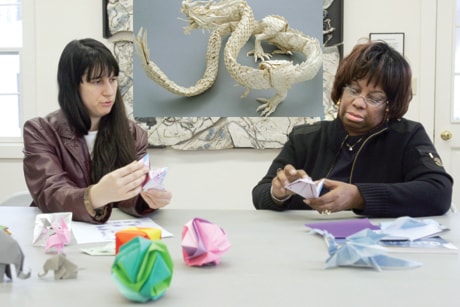Linda Morrissey’s introduction to the ancient art of origami was uniquely modern: it happened because of a job she had giving technical support over the phone.
“I was looking for something to do with my hands,” said the Toledo, Ohio, woman, who taught herself paper folding after checking out books from the library.
That was seven years ago. Now, she’s not working on the phone anymore, but her hands are still busy creating challenging forms, still offering lessons and continuing a tradition that goes back centuries.
“It’s just absolutely amazing that you can take this flat piece of paper and turn it into a three-dimensional animal or whatever,” she said.
“It’s magical.”
“Some people say that the invention of paper was created (in China) about 105 A.D. and that paper folding must have been invented soon afterwards,” said Carolyn Putney, curator of Asian art at the Toledo Museum of Art.
The country credited with truly developing the practice is Japan, where certain origami designs even were incorporated into religious ceremonies. The word itself comes from the Japanese “oru,” meaning “to fold,” and “kami,” which means “paper,” but is also a homonym for “spirit” or “god.”
Only the most basic designs were kept and passed down through families, Putney said. The first book showing Japanese paper folding methods didn’t come out until 1797, and modern origami, with its flurry of new models, waited until the 1950s.
There are two basic rules for traditional origami: one piece of square paper and no cutting, although there are schools that deviate from this.
Even with such challenging limitations, the results can be astounding, much more than child’s play.
Wikpedia reports that in the early days of origami, designs were largely a mix of trial-and-error, luck and serendipity.
With advances in computer plotting, the structure of a new origami model can be laid out before any folding even occurs.
This method of origami design allows for the creation of extremely complex multi-limbed models such as many-legged centipedes, human figures with a full complement of fingers and toes, and the like.
At one point, Wikipedia reported Japanese scientists and origami masters had proposed to launch a flotilla of paper planes from space. The launch was tentatively slated for this year from the International Space Station. Around 30 planes were proposed glide downward over what is expected to be the course of months.
If even one of the planes survived, it would be the longest flight ever by a paper plane, traversing some 400 km.
“I think people look on it as something that children do. The Japanese masters who do it don’t consider it a children’s game or craft at all because they’re far more adept than that,” said William Peck, a retired curator from the Detroit Institute of Arts and origami enthusiast.
“The most complicated one used to make regularly was a crab with all eight legs and two pincers.”
“I used to do it instead of doodling,” he said. “In a meeting, it would become a little distracting to people because I would be making paper animals.”
Today origami is used from hand and cognitive therapy to understanding geometry. Some people think of it as a good means for teaching hand-eye coordination, others as pure art, according to Jan Polish, a volunteer with OrigamiUSA, an organization devoted to spreading the joys of paper folding.
No matter how it’s used, the satisfaction at the final product remains the same.
“It’s like a puzzle trying to figure out how to fold something,” Morrissey said. “I can say, ’Ha! I did it! I’m proud of myself.’ “
